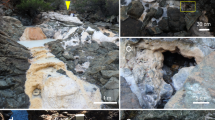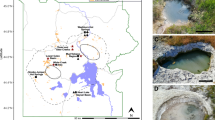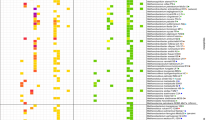Abstract
In the present study, we tested the hypothesis that animal treading associated with a high input of organic matter would favour methanogenesis in soils used as overwintering pasture. Hence, methane emissions and methanogen populations were examined at sections with different degree of cattle impact in a Farm in South Bohemia, Czech Republic. In spring, methane emission positively corresponded to the gradient of animal impact. Applying phospholipid etherlipid analysis, the highest archaeal biomass was found in section severe impact (SI), followed by moderate impact (MI) and no impact. The same trend was observed for the methanogens as showed by real-time quantitative PCR analyses of methyl coenzyme M reductase (mcrA) genes. The detection of monounsaturated isoprenoid side chain hydrocarbons (i20:1) indicated the presence of acetoclastic methanogens in the cattle-impacted sites. This result was corroborated by the phylogenetic analysis of mcrA gene sequences obtained from section SI, which showed that 33% of the analysed clones belonged to the genus Methanosarcina. The majority of the sequenced clones (41%) showed close affiliations with uncultured rumen archaeons. This leads to the assumption that a substantial part of the methanogenic community in plot SI derived from the grazing cattle itself. Compared to the spring sampling, in autumn, a significant reduction in archaeal biomass and number of copies of mcrA genes was observed mainly for section MI. It can be concluded that after 5 months without cattle impact, the severely impact section maintained its methane production potential, whereas the methane production potential under moderate impact returned to background values.
Similar content being viewed by others
Log in or create a free account to read this content
Gain free access to this article, as well as selected content from this journal and more on nature.com
or
References
Bai Q, Gattinger A, Zelles L . (2000). Characterisation of microbial consortia in paddy rice soil by phosholipid analysis. Microb Ecol 39: 273–281.
Beeman RE, Suflita JM . (1990). Environmental factors influencing methanogenesis in a shallow anoxic aquifer: a field and laboratory study. J Ind Microbiol 5: 45–57.
Boix-Fayos C, Calvo-Cases A, Imeson AC . (2001). Influence of soil properties on the aggregation of some Mediterranean soils and the use of aggregate size and stability as land degradation indicators. Catene 44: 47–67.
Castaldi S, Costantini M, Cenciarelli P, Ciccioli P, Valentini R . (2007). The methane sink associated to soils of natural and agricultural ecosystems in Italy. Chemosphere 66: 723–729.
Chan ASK, Parkin TB . (2001). Methane oxidation and production activity in soils from natural and agricultrual ecosystems. J Environ Qual 301: 1896–1903.
Clayton H, Arah JRM, Smith KA . (1994). Measurement of nitrous oxide emissions from fertilized grassland using closed chambers. J Geophys Res 99: 599–607.
Ellermann J, Hedderich R, Bocher R, Thauer RK . (1988). The final step in methane formation. Investigations with highly purified methyl-CoM reductase (component C) from Methanobacterium thermoautotrophicum (strain Marburg). Eur J Biochem 172: 669–677.
Gattinger A . (2001). Entwicklung und Anwendung von Methoden zur Charakterisierung von mikrobiellen Gemeischaften in oxischen und Bodenökosystem anhand von Phospholipid-Profilen. Fakultät Wissenschaftszentrum Weihehstephan für Ernährung, Landnutzung und Umwelt. Technische Universität München: Munich, p 147.
Gattinger A, Hofle MG, Schloter M, Embacher A, Bohme F, Munch JC et al. (2007). Traditional cattle manure application determines abundance, diversity and activity of methanogenic Archaea in arable European soil. Environ Microbiol 9: 612–624.
Gattinger A, Günthner A, Schloter M, Munch JC . (2003). Characterization of Archaea in soils by polar lipid analysis. Acta Biotechnol 23: 21–28.
Gattinger A, Ruser R, Schloter M, Munch JC . (2002). Microbial community structure varies in different soil zones of a potato field. J Plant Nutr Soil Sci 165: 421–428.
Griffiths RI, Whiteley AS, O’Donnell AG, Bailey MJ . (2000). Rapid method for coextraction of DNA and RNA from natural environments for analysis of ribosomal DNA- and rRNA-based microbial community composition. Appl Environ Microbiol 66: 5488–5491.
Hernández D, Fernández JM, Plaza C, Polo A . (2007). Water-soluble organic matter and biological activity of a degraded soil amended with pig slurry. Sci Total Environ (in press).
Hütsch BW, Webster CP, Powlson DS . (1993). Long-term effects of nitrogen fertilization on methane oxidation in soil of the broadbalk wheat experiment. Soil Biol Biochem 25: 1307–1310.
Hütsch BW, Webster CP, Powlson DS . (1994). Methane oxidation in soil as affected by land use, soil pH and N fertilization. Soil Biol Biochem 26: 1613–1622.
Jackson ML . (1958). Soil Chemical Analysis. Prentice Hall: Englewood Cliffs: New York.
Jarvis GN, Strompl C, Burgess DM, Skillman LC, Moore ER, Joblin KN . (2000). Isolation and identification of ruminal methanogens from grazing cattle. Curr Microbiol 40: 327–332.
Juottonen H, Galand PE, Yrjälä K . (2006). Detection of methanogenic Archaea in peat: comparison of PCR primers targeting the mcrA gene. Res Microbiol 15: 914–921.
Lueders T, Chin K-J, Conrad R, Friedrich M . (2001). Molecular analyses of methyl-coenzyme M reductase α-subunit (mcrA) genes in rice field soil and enrichment cultures reveal the methanogenic phenotype of a novel archaeal lineage. Environ Microbiol 3: 194–204.
Luton PE, Wayne JM, Sharp RJ, Riley PW . (2002). The mcrA gene as an alternative to 16S rRNA in the phylogenetic analysis of methanogen populations in ladfill. Microbiology 148: 3521–3530.
Martens DA, Frankenberger WT . (1992). Modification of infiltration rates in an organic-amended irrigated soil. Agron J 84: 707–717.
Menneer JC, Ledgard S, McLay C, Silverster W . (2005). Animal treading stimulates denitrification in soil under pasture. Soil Biol Biochem 37: 1625–1629.
Mosier A, Schimel D, Valentine D, Bronson K, Parton W . (1991). Methane and nitrous oxide fluxes in native, fertilized and cultivated grasslands. Nature 350: 330–332.
OCA (2006). Organic agriculture can help stabilize global climate change. Organic Consumers Association, http://www.organicconsumers.org/organic/stabalize062404.cfm.
Oenema O, Velthof G, Kuikman P . (2001). Technical and policy aspects of strategies to decrease greenhouse gas emissions from agriculture. Nutr Cycl Agroecosys 60: 301–315.
Oravecz O, Elhottovás D, Kristufek V, Sustr V, Frouz J, Triska J et al. (2004). Application of ARDRA and PLFA analysis in characterizing the bacterial communities of the food, gut and excrement of saprophagous larvae of Penthetria holosericea (Diptera: Bibionidae): a pilot study. Folia Microbiol (Praha) 49: 83–93.
Pare T, Dinel H, Moulin AP, Townley-Smith L . (1999). Organic matter quality and structural stability of a Black Chernozemic soil under different manure and tillage practices. Geoderma 91: 311–326.
Plaza C, García-Gil JC, Polo A . (2007). Microbial activity in pig slurry-amended soils under aerobic incubation. Biodegradation 18: 159–165.
Ramakrishnan B, Lueders T, Dunfield PF, Conrad R, Friedrich MW . (2001). Archaeal community structures in rice soils from different geographical regions before and after initiation of methane production. FEMS Microbiol Ecol 37: 175–186.
Schnell S, King GM . (1994). Mechanistic analysis of ammonium inhibition of atmospheric methane consumption in forest soils. Appl Environ Microbiol 60: 3514–3521.
Sharma S, Radl V, Hai B, Kloos K, Fuka M, Engel M et al. (2007). Quantification of functional genes from procaryotes in soil by PCR. J Microbiol Methods 68: 445–452.
Sherlock RR, Sommer SG, Khan RZ, Wood CW, Guertal EA, Freney JR et al. (2002). Ammonia, methane, and nitrous oxide emission from pig slurry applied to a pasture in New Zealand. J Environ Qual 31: 1491–1501.
Šimek M, Brucek P, Hynšt J, Uhlírová E, Petersen SO. (2006). Effects of excretal returns and soil compaction on nitrous oxide emissions from a cattle overwintering area. Agr Ecosys Environ 112: 186–191.
Sommer SG, Sherlock RR, Khan RZ . (1996). Nitrous oxide and methane emissions from pig slurry amended soils. Soil Biol Biochem 28: 1541–1544.
Tatsuoka N, Mohammed N, Mitsumori M, Hara K, Kurihara M, Itabashi H . (2004). Phylogenetic analysis of methyl coenzyme-M reductase detected from the bovine rumen doi:10.1111/j.1472-765X.2004.01566.x. Lett Appl Microbiol 39: 257–260.
Thauer R . (1998). Biochemistry of methanogenesis: a tribute to Marjory Stephenson. 1998 Marjory Stephenson Prize Lecture. Microbiology 144: 2377–2406.
Wachinger G, Fiedler S, Zepp K, Gattinger A, Sommer M, Roth K . (2000). High spatial variability of methane production on the micro-scale: spatial association with hot spots of organic material and archaeal populations. Soil Biol Biochem 32: 1121–1130.
Wagner D, Lipski A, Embacher A, Gattinger A . (2005). Methane fluxes in permafrost habitats of the Lena Delta: effects of microbial community structure and organic matter quality. Environ Microbiol 7: 1582–1592.
White SL, Sheffield RE, Washburn SP, King LD, Green Jr JT . (2001). Spatial and time distribution of dairy cattle excreta in an intensive pasture system. J Environ Qual 30: 2180–2187.
Zbíral J . (1995). Soil Analyses, Part I. Czech Central Institute for Supervising and Testing in Agriculture: Brno (in Czech).
Zbíral J, Honsa I, Malý S . (1997). Soil Analyses, Part III. Czech Central Institute for Supervising and Testing in Agriculture: Brno (in Czech).
Zelles L . (1999). Identification of single cultured micro-organisms based on their whole-community fatty acid profiles, using an extended extraction procedure. Chemosphere 39: 665–682.
Zelles L, Bai QY . (1993). Fractionation of fatty acids derived from soil lipids by soil phase extraction and their quantitative analysis by GC-MS. Soil Biol Biochem 25: 130–134.
Acknowledgements
This study was supported by a grant from the DAAD (German academic exchange program) and by the Ministry of Education of the Czech Republic (LC06066) Grant Agency of the Academy of Sciences of the Czech Republic (IAA600660605) the Research Plan of the Biology Centre, Institute of Soil Biology (AV 0Z 60660521). V Šlajchrtová, E Zadáková and Conny Galonska are greatly acknowledged for field work and laboratory analyses. Mr and Mrs Kamír are thanked for allowing access to the experimental plot and for their significant support in field work. We also wish to thank the two anonymous reviewers for their helpful comments.
Author information
Authors and Affiliations
Corresponding author
Rights and permissions
About this article
Cite this article
Radl, V., Gattinger, A., Chroňáková, A. et al. Effects of cattle husbandry on abundance and activity of methanogenic archaea in upland soils. ISME J 1, 443–452 (2007). https://doi.org/10.1038/ismej.2007.60
Received:
Revised:
Accepted:
Published:
Issue date:
DOI: https://doi.org/10.1038/ismej.2007.60
Keywords
This article is cited by
-
The impact of long-term organic farming on soil-derived greenhouse gas emissions
Scientific Reports (2019)
-
Soil carbon dioxide and methane fluxes from forests and other land use types in an African tropical montane region
Biogeochemistry (2019)
-
Dung application increases CH4 production potential and alters the composition and abundance of methanogen community in restored peatland soils from Europe
Biology and Fertility of Soils (2018)
-
Evaluating the lingering effect of livestock grazing on functional potentials of microbial communities in Tibetan grassland soils
Plant and Soil (2016)
-
Manure-associated stimulation of soil-borne methanogenic activity in agricultural soils
Biology and Fertility of Soils (2015)



